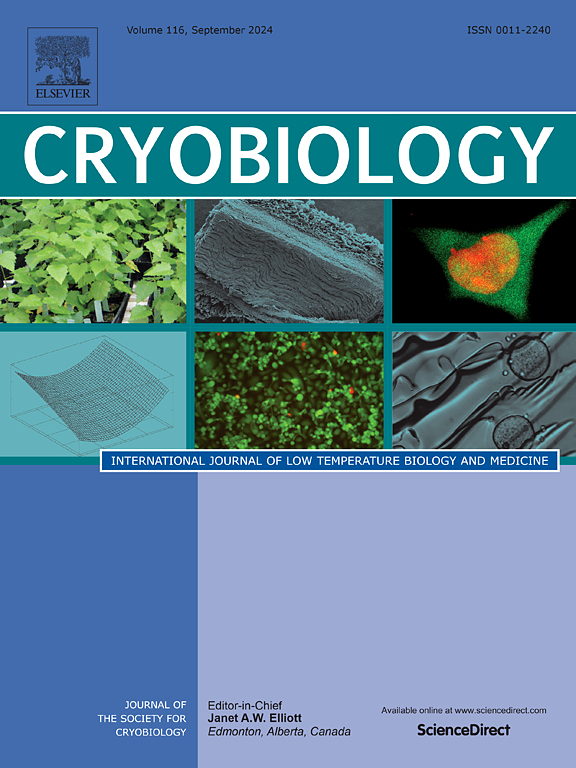BGP-15通过减轻低温保存过程中的氧化应激来改善山羊精子的质量
IF 2.1
3区 生物学
Q2 BIOLOGY
引用次数: 0
摘要
本研究的目的是评价bp -15 ((Z)- n '-(2-羟基-3-(胡椒苷-1-基)丙氧基)烟酰胺)对山羊精子冷冻保存的影响。6只公羊的精液用含有不同剂量bp -15(0、50、100、150和200 μM)的大豆卵磷脂填充剂稀释。在冻融过程中,评估解冻后雄性精子的精子特征、质膜完整性和功能、顶体状态、线粒体活性、细胞凋亡状态和基因表达。与新鲜精子相比,冷冻精子的超微结构受到破坏,双微管数量减少,分布部分不对称,中心微管局部消失,亚微管结构模糊。此外,与对照组相比,100 μM bp -15处理组冻融精子的活力、质膜和顶体完整性以及线粒体活性百分比最高(P <;0.05)。在计算机辅助精液分析仪中,与对照组相比,BGP-15治疗组的精子活力参数显著增加(P <;0.05),除了抖动。同样,与对照组相比,bp -15处理增加了T-AOC、SOD、CAT和GHS-Px水平,降低了ROS水平(P <;0.05)。只有100 μM bp -15治疗组MDA水平高于对照组(P <;0.05)。在所有bp -15处理组中,ROMO1基因的mRNA表达量均显著低于对照组(P <;0.05), SMCP、MnSOD和CuZnSOD基因mRNA表达量显著升高(P <;0.05)。而50 μM bp -15治疗组与对照组间SMOX基因mRNA表达差异无统计学意义(P >;0.05)。与对照组相比,100 μM bp -15处理组冻融精子的凋亡率显著降低(P <;100 μM bp -15处理组冷冻解冻精子的MMP显著升高(P <;0.05)。综上所述,bp -15增强了山羊精子的低温保护作用,在冷冻保存过程中添加100 μM bp -15扩展剂有利于山羊养殖业的发展。本文章由计算机程序翻译,如有差异,请以英文原文为准。

BGP-15 improves quality of goat sperm by mitigating oxidative stress during cryopreservation
The objective of this study was to evaluate the effect of the addition of BGP-15 ((Z)-N'-(2-hydroxy-3-(piperidin-1-yl) propoxy) nicotinimidamide) on goat sperm during cryopreservation. The semen from six rams was diluted with a soybean lecithin-based extender containing different doses of BGP-15 (0, 50, 100, 150, and 200 μM). After the freeze-thawing process, sperm characteristics, plasma membrane integrity and functionality, acrosomal status, mitochondria activity, apoptosis status, and gene expression of post-thawed ram spermatozoa were assessed. Compared to fresh spermatozoa, the ultrastructure of frozen spermatozoa was damaged, and frozen spermatozoa had a reduced number of duplex microtubules with partially asymmetric distributions, localized disappearance of the central microtubule, and ambiguous submicrotubule structures. Moreover, the 100 μM BGP-15 treatment group had the highest percentage of viability, plasma membrane and acrosome integrities, and mitochondrial activity of frozen-thawed spermatozoa when compared to the control (P < 0.05). In the Computer-Assisted Semen Analyzer, sperm motility parameters were significantly increased in the BGP-15 treatment group against the control group (P < 0.05), except wobble. Similarly, BGP-15 treatment increased the levels of T-AOC, SOD, CAT, and GHS-Px and decreased the level of ROS which compared to controls (P < 0.05). Only the 100 μM BGP-15 treatment group had a higher MDA level than the control group (P < 0.05). In all BGP-15 treatment groups, the mRNA expressions of the ROMO1 gene were significantly reduced compared to controls (P < 0.05), and the mRNA expressions of the SMCP, MnSOD, and CuZnSOD genes were significantly increased (P < 0.05). While the difference in the mRNA expression of the SMOX gene between the 50 μM BGP-15 treatment group and the control group was not significant (P > 0.05). Moreover, the apoptosis rate of freeze-thawed spermatozoa significantly decreased in the 100 μM BGP-15 treatment group compared to the control (P < 0.05), while the MMP of freeze-thawed spermatozoa significantly enhanced in the 100 μM BGP-15 treatment group (P < 0.05). In conclusion, BGP-15 enhances cryo-protective effects on goat spermatozoa, and 100 μM BGP-15 addition to the extender during cryopreservation is beneficial to the goat breeding industry.
求助全文
通过发布文献求助,成功后即可免费获取论文全文。
去求助
来源期刊

Cryobiology
生物-生理学
CiteScore
5.40
自引率
7.40%
发文量
71
审稿时长
56 days
期刊介绍:
Cryobiology: International Journal of Low Temperature Biology and Medicine publishes research articles on all aspects of low temperature biology and medicine.
Research Areas include:
• Cryoprotective additives and their pharmacological actions
• Cryosurgery
• Freeze-drying
• Freezing
• Frost hardiness in plants
• Hibernation
• Hypothermia
• Medical applications of reduced temperature
• Perfusion of organs
• All pertinent methodologies
Cryobiology is the official journal of the Society for Cryobiology.
 求助内容:
求助内容: 应助结果提醒方式:
应助结果提醒方式:


